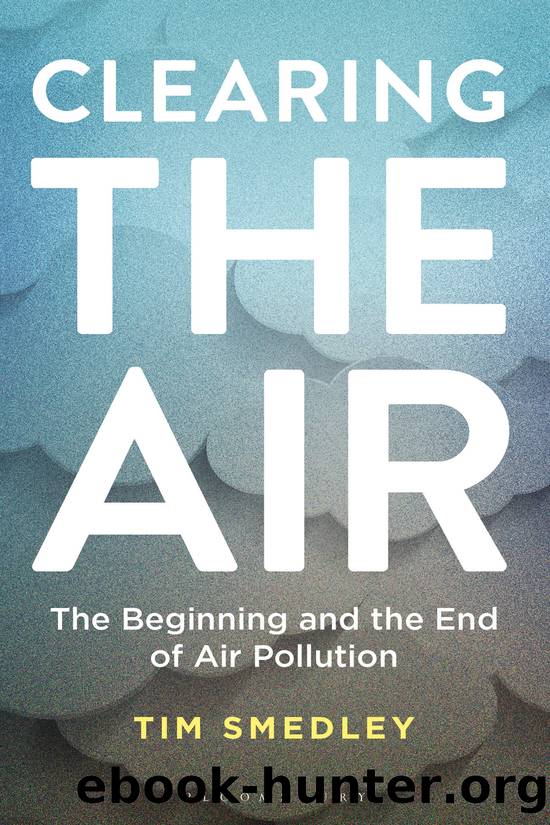Clearing the Air_The Beginning and the End of Air Pollution by Tim Smedley

Author:Tim Smedley [Smedley, Tim]
Language: eng
Format: epub
Tags: Science
ISBN: 9781472953308
Google: 2-twDwAAQBAJ
Amazon: B07HWPB9L4
Goodreads: 40653218
Publisher: Bloomsbury SIGMA
Published: 2019-03-21T00:00:00+00:00
Beijingâs Olympian feat
In the spring of 2014, Chinaâs President Xi Jinping stepped outside for a photoshoot in the smog. Chinese anthologist Jerry Zee later described its significance as a moment when, âthe highest official in China allowed himself to be captured throwing in his lot with the common Beijinger ⦠held together not by citizenship but by shared exposure to toxic weather.â Beijing residents had flooded social media with facemask selfies, holding placards reading â#I donât want to be a human vacuum cleanerâ (#æä¸è¦å人èå¸å°å¨), and were getting a response. Xi Jinpingâs number two, Li Keqiang, gave a speech later describing air pollution as ânature's red-light warning against inefficient and blind developmentâ. Live on Chinese state television he declared a âwar against pollutionâ. It was a game changer. Li immediately outlined the measures to be taken: reducing PM and eliminating outdated power stations and industrial plants. China cut steel production capacity by over 27 million tonnes (the equivalent of Italyâs entire output), slashed cement production by 42 million tonnes and shut down 50,000 small coal-fired furnaces. Li promised to change âthe way energy is consumed and producedâ and to promote green and low-carbon technology. Beijing, until recently reliant on coal for its energy, closed its last remaining coal-fired power station in 2017.
The Beijing-based Institute of Public & Environmental Affairs (IPE) is a short but confusing walk from Jianguomen Metro station, and when I arrive at the tower block there is no company or organisation branding, simply unmarked doors and an elevator. I phone to check I am at the right place, and am told to come up a few floors, where Iâm met by a young American who speaks fluent Chinese, Kate Logan, a director at IPE and a board member of the Beijing Energy Network. She offers me the customary drink of steaming hot water. IPE was founded in 2006 by Chinese environmental activist Ma Jun to promote information transparency and public participation in environmental reporting, and was Chinaâs first genuinely independent environmental non-profit. IPE began by collecting public (but often obscure) environmental information and collating it into an easily accessible database. This became the China Water Pollution Map, and later a broader database of environmental violations including air quality information known as the âBlue Sky Roadmapâ. Iâm intrigued to know how IPE got away with openly criticising the government in the days when air pollution was not officially recognised, publishing statements such as âlarge cities are increasingly suffering from the rapidly expanding and serious problem of air pollutionâ and criticising âChinaâs lax environmental supervision and the low cost associated with violatingâ as early as 2011.
âIn the beginning it was very sensitive in a lot of ways,â admits Logan. âI think when IPE first started producing the database, the specific decision was made to only take information from government sources or officially verified sources. That was basically a means of mitigating that sensitivity ⦠if anyone came doubting the validity of the data, you can verify the source [because] itâs an official source.
Download
This site does not store any files on its server. We only index and link to content provided by other sites. Please contact the content providers to delete copyright contents if any and email us, we'll remove relevant links or contents immediately.
Whiskies Galore by Ian Buxton(41704)
Introduction to Aircraft Design (Cambridge Aerospace Series) by John P. Fielding(33008)
Small Unmanned Fixed-wing Aircraft Design by Andrew J. Keane Andras Sobester James P. Scanlan & András Sóbester & James P. Scanlan(32676)
Craft Beer for the Homebrewer by Michael Agnew(18068)
Turbulence by E. J. Noyes(7884)
The Complete Stick Figure Physics Tutorials by Allen Sarah(7253)
Kaplan MCAT General Chemistry Review by Kaplan(6806)
The Thirst by Nesbo Jo(6744)
Bad Blood by John Carreyrou(6464)
Modelling of Convective Heat and Mass Transfer in Rotating Flows by Igor V. Shevchuk(6345)
Learning SQL by Alan Beaulieu(6148)
Weapons of Math Destruction by Cathy O'Neil(6069)
Man-made Catastrophes and Risk Information Concealment by Dmitry Chernov & Didier Sornette(5862)
Digital Minimalism by Cal Newport;(5570)
Life 3.0: Being Human in the Age of Artificial Intelligence by Tegmark Max(5391)
iGen by Jean M. Twenge(5290)
Secrets of Antigravity Propulsion: Tesla, UFOs, and Classified Aerospace Technology by Ph.D. Paul A. Laviolette(5229)
Design of Trajectory Optimization Approach for Space Maneuver Vehicle Skip Entry Problems by Runqi Chai & Al Savvaris & Antonios Tsourdos & Senchun Chai(4946)
Electronic Devices & Circuits by Jacob Millman & Christos C. Halkias(4857)
